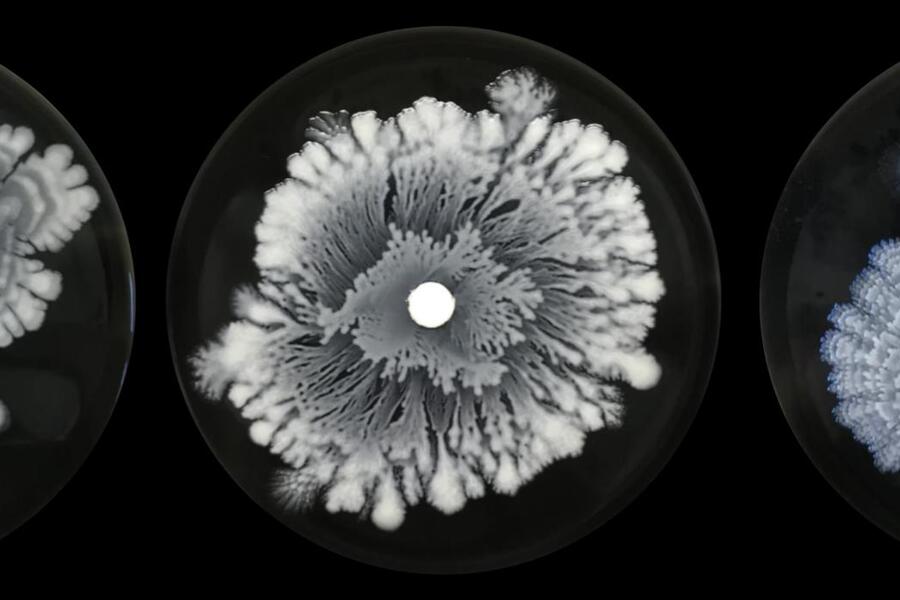- Name
- Alexandria Carolan
- acarola1@jh.edu
- Name
- Vanessa Wasta
- wasta@jhmi.edu
- Office phone
- 410-955-8236
Equipped with a suitcase full of honey, high school sophomore Carson Shin contacted university after university, hoping to work with expert biochemists to investigate the sticky substance's antimicrobial properties.
The only problem? Scientists seemed wary of collaborating with a 15-year-old.

Image caption: Carson Shin
Shin couldn't have predicted that, five years later, he would co-author a Johns Hopkins Medicine report showing that dormant and previously undescribed bacteria found in raw honey produce antibiotics that can kill the bacterial pathogen Legionella. The pathogen can be found in potable water and causes Legionnaires' disease, a life-threatening pneumonia that kills one in 10 people infected with it.
The published report not only offers a first step in the development of new antibiotics for Legionella, but has the potential to aid in the fight against antibiotic resistance, says senior author Tamara O'Connor, assistant professor of biological chemistry at Johns Hopkins University School of Medicine.
Shin reached out to O'Connor in the spring of 2019, beginning a summer internship with the professor that he hoped would uncover a novel antimicrobial property of honey.
"Carson showed tremendous initiative and was very inquisitive," O'Connor says. "It's exciting to have any student join the lab who demonstrates this level of intellectual engagement in science."
Initially, Shin and O'Connor exposed Legionella to raw, unpasteurized honey, to test whether the natural substance could kill the bacteria. Surprisingly, honey had little effect on Legionella. However, in the course of these experiments, they identified several different bacteria in the honey that, in response to Legionella, produced and secreted antibiotics that were lethal to the pathogen.
"We found the right conditions for the honey bacteria to thrive, allowing us to tap into a resource we didn't know was there," Shin says.
In nature, O'Connor says, "bacteria figure out ways to outcompete one another, which often involves releasing toxic molecules that kill their competitors." The honey bacteria Shin and O'Connor isolated "recognize Legionella as competition and launch a deadly response."
The honey bacteria were identified as members of the Bacillus and Lysinibacillus genera of bacteria. This is not surprising, O'Connor says, because bacilli produce spores that are protected from the antimicrobial properties of honey. These bacteria are commonly found in raw honey, explaining why it is recommended to eat only pasteurized honey, she says.
Upon sequencing the genomes of two of the bacterial isolates, strain AHB2 and strain AHB11, the researchers identified them as members of the species Bacillus safensis. Previously, the ability for this group of bacteria to produce antibacterial molecules was not well-documented.
Further experiments revealed how specific the response of honey bacteria to Legionella was.
"Remarkably, the bacteria in honey only produce these antibacterial molecules in response to Legionella species, as none of the other bacterial pathogens we exposed them to elicited this response," O'Connor says.

Image caption: Tamara O'Connor
While other pathogens did not cause honey bacteria to produce these antibiotics, many were susceptible to them, O'Connor says. These results suggest antibacterial molecules produced by honey could target other harmful pathogens and could be used as broad-spectrum antibiotics. While these preliminary findings offer the identification of new antibacterial molecules, more research is needed to determine their potential for developing viable therapeutics, O'Connor says.
Antimicrobial resistance is one of the largest threats to global public health, contributing to nearly 5 million deaths in 2019, according to the World Health Organization—creating a dire need for the development of new antibiotics to treat bacterial infections.
Similar studies of the biowarfare between microorganisms have led scientists to identify many antimicrobial molecules, says O'Connor. The vast majority of antibiotics prescribed by physicians originate from natural products, she says.
"The ability to tap into these resources by identifying new bacteria and the conditions that cause them to produce antibacterial molecules is critical in the fight against antibiotic resistance," she says.
Young scientists like Shin are crucial to combat antibiotic resistance, O'Connor says.
"Carson exemplifies how the curiosity of an aspiring young scientist can lead to exciting new discoveries," she says.
Shin, who is beginning his senior year of college this fall at the University of Pennsylvania, said his experience at Johns Hopkins influenced his decision to study anthropology. Before reaching out to O'Connor, Shin had looked into raw honey's historic and ancient role in traditional medicines of the Egyptians, Greeks, and Islamic countries over thousands of years.
"Our research stems from studying culture. You can learn valuable information about medicine from cultures across the world and across time," Shin says.
The research was supported independently by the Department of Biological Chemistry and the Johns Hopkins University School of Medicine.
Posted in Health
Tagged antibiotics, department of biological chemistry, bacteria








